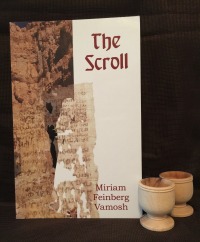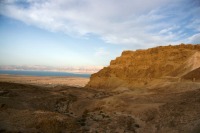As a Christian, I have always viewed the first and second centuries C.E. through the lens of early church writings and perspective. I am grateful for Miriam Feinberg Vamosh’s novel, The Scroll, for its vivid portrayal of the same time period but offered from the viewpoint of the vanquished Jews.
 The novel succeeds admirably in drawing readers into the Jewish struggle against Roman oppressors from the time of Masada’s downfall in 73 C.E. onward through the Bar Kochba rebellion a half-century later. Each succeeding generation faces the choice of resisting or submitting to the enemy, dividing families and pitting Jew against Jew in the fight to survive as a people. Vamosh brilliantly builds on an actual document of divorce recovered through archeological efforts and weaves a fictional tale rich in detail, with finely drawn characters who lead the reader through the historically real landscape of Roman brutality and a people determined to preserve their legacy for future generations.
The novel succeeds admirably in drawing readers into the Jewish struggle against Roman oppressors from the time of Masada’s downfall in 73 C.E. onward through the Bar Kochba rebellion a half-century later. Each succeeding generation faces the choice of resisting or submitting to the enemy, dividing families and pitting Jew against Jew in the fight to survive as a people. Vamosh brilliantly builds on an actual document of divorce recovered through archeological efforts and weaves a fictional tale rich in detail, with finely drawn characters who lead the reader through the historically real landscape of Roman brutality and a people determined to preserve their legacy for future generations.
About the Author
Miriam Feinberg Vamosh is the successful author of several nonfiction books about ancient times in Israel. Her books have been translated into more than 30 languages and include Daily Life in the Time of Jesus, Food at the Time of the Bible, Women at the Time of the Bible, and Israel: Land of the Bible. She serves as an editor on the Israeli daily newspaper, Haaretz English Edition, as well as a translator in archeology and heritage, and is a favorite guide for pilgrims touring the Holy Land. Although The Scroll is her first foray into fiction writing, Vamosh’s historical expertise shines in her detailed descriptions of everyday life, including gender roles, the treatment of slaves, food preparation, ceremonial dress, and myriad other details you would be hard pressed to find in other novels of this same time period.
What Is Masada?
Masada is an ancient mountaintop fortress rising 1,424 feet to overlook desert plains and the southwest coast of the Dead Sea. Located not far from Jerusalem, it is most famous as the site of the Jewish rebels’ last stand against their Roman conquerors.
 Fortified by several leaders of the Hasmonean dynasty, Masada was chiefly developed by King Herod the Great, a brilliant but paranoid king who built up an impregnable citadel for himself. He constructed two palaces on the site with thick walls, defensive towers, and aqueducts that filled cisterns with enough water to sustain life year-round. After Herod died in 4 B.C.E., the Romans claimed the fortress, but Jewish zealots recaptured it and held it from 66 C.E. through the fall of Jerusalem to the Romans in 70 C.E. On a mission to wipe out every vestige of Jewish resistance, the Romans laid siege to the fortress but were unable to scale the cliff. A Roman army of nearly 15,000 were held at bay by fewer than 1,000 Jews, many of them women and children. After two years of siege, the Romans managed to build a ramp made of earth and stones and finally breached the wall.
Fortified by several leaders of the Hasmonean dynasty, Masada was chiefly developed by King Herod the Great, a brilliant but paranoid king who built up an impregnable citadel for himself. He constructed two palaces on the site with thick walls, defensive towers, and aqueducts that filled cisterns with enough water to sustain life year-round. After Herod died in 4 B.C.E., the Romans claimed the fortress, but Jewish zealots recaptured it and held it from 66 C.E. through the fall of Jerusalem to the Romans in 70 C.E. On a mission to wipe out every vestige of Jewish resistance, the Romans laid siege to the fortress but were unable to scale the cliff. A Roman army of nearly 15,000 were held at bay by fewer than 1,000 Jews, many of them women and children. After two years of siege, the Romans managed to build a ramp made of earth and stones and finally breached the wall.
According to the historian Josephus, when the Romans burst through the fortress wall, they found dead Jews everywhere. Plentiful food and water proved that the Jews had not died of starvation or thirst but had chosen to kill themselves rather than submit to Roman authority. Only two women and five children, hidden in a water conduit, survived Masada. Vamosh’s story spins a fictional account of what happened to these survivors and how one woman’s courage, wit, and determined faith preserved the legacy of Masada for her people.
Purchase The Scroll on Amazon: Paperback or Kindle.
Follow The Scroll on Facebook.
Learn more about the author at miriamfeinbergvamosh.com.




Leave a Reply